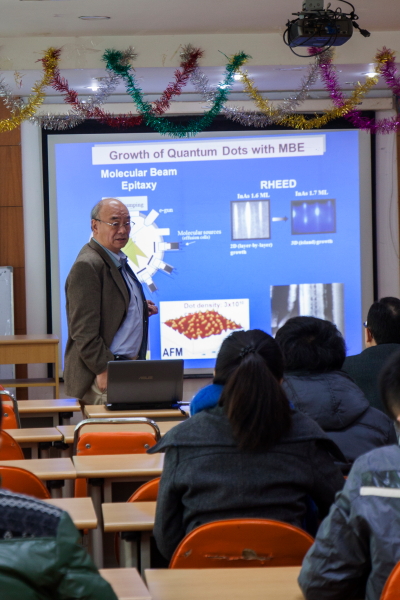On November 30th, Professor Jim-Yong Chi from National Chung-Hsing University (NCHU), Taichung, Taiwan, delivered an academic report titled Quantum Dot Lasers. The main content is the InAs/InGaAs Quantum Dots in VCSEL Microcavity for Nanophotonics Research. Zhang Xingyu, Associate Dean of College of Information Science and Engineering, hosted the report. Part of the faculty and the students attended the lecture.
Prof. Chi firstly gave a brief introduction of the gist and the related area of his report. Then he listed the advantages of quantum dot lasers and introduced the evolution of 1.3um VCSEL Research in ITRI and Quantum Dot Growth modes. Then he discussed Submonolayer QD VCSEL and VCSEL Micorcarity in details, including the advantages of QD for VCSEL, the parameters selection of quantum dot and the technical details of Vertically Coupled QDLDS、SML QDs VCSEL. On basis of quantum dot, he extended to slow light measurement and slow track. At last he briefly explained the application of all the technology above.
After the report, Professor Chi patiently answered the questions from the audience and exchanged ideas with them. And he was warmly applauded by the listeners.
Jim-Yong Chi, American, got his Bachelor from Physics from National Tsinghua University, Taiwan, in 1971, Physics Master from New York State University in buffalo and Ph.D from Material Science of MIT in 1980. He had ever been a researcher in MIT and Bell Labs in Holmdel, New Jersey. In GTE Labs, Waltham, Massachusetts, He developed DFB grating on the base of InP and InGaAs/InAlAs by molecular beam epitaxy to explore their characteristics and applications of quantum well devices. He extended the lifetime of high power LD from 300 hours to a million hours when he was the chief engineering of Polaroid Company in Cambridge, Massachusetts. He had been the chief senior engineering in MACON in Lowell, Massachusetts. As the Director of center of nanophotonics in Institute of Industrial Technology in Xinzhu, Taiwan, he researched on technology of LD and LED and created six LD devices and demonstrated the first quantum dot lasers and vertical cavity surface emitting laser diode. He enhanced the LED efficiency using one and two dimension photonic crystal and transferred the technology of lasers and metal organic chemical vapor deposition to the related industry in Taiwan. Now he is the Professor and director of Photoelectric Engineering Institute in NCTU, Taiwan. He has published over 160 SCI papers which were cited over 1200 times and owns 7 patents.

